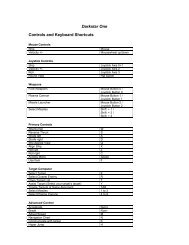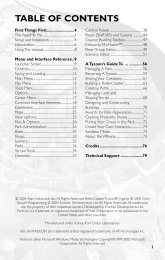Heads-Up Display Modes 35 - Metaboli
Heads-Up Display Modes 35 - Metaboli
Heads-Up Display Modes 35 - Metaboli
Create successful ePaper yourself
Turn your PDF publications into a flip-book with our unique Google optimized e-Paper software.
Air-To-Air Missiles 83<br />
Typical Missile Envelope Against a Co-altitude, Non-maneuvering Target<br />
Notice the right-hand illustration in the figure above. This shows the second major<br />
factor in missile range: altitude. Generally speaking, a missile’s kinematic range<br />
doubles for each 6,100 m (20,000 ft) that altitude is increased. For example, if the<br />
missile’s kinematic range is 20 km at sea level, it will double to approximately 40<br />
km when fired at a co-altitude target 6,100 m higher. At 12,200 m (approximately<br />
40,000 ft), missile range would increase to 80 km. When fired at a higher or lower<br />
target, the missile’s range is generally associated with the median altitude<br />
between the shooter and the target (assuming the missile can climb high enough<br />
when fired at a higher altitude target).<br />
Finally, the speed of the launching aircraft greatly impacts missile kinematic range.<br />
The slower the launcher is moving, the longer the missile will take to reach<br />
maximum speed. More of its limited motor burn will be spent accelerating to<br />
cruise speed. If the missile is launched at a higher speed, it will reach cruise<br />
speed and altitude faster, saving more of the motor burn for the “cruise” portion<br />
of the flight. Likewise, the speed of the target impacts the missile range as well.<br />
The faster the target is moving, the more distance it will cover during the missile’s<br />
time of flight. In a tail-chase scenario, the target may escape the missile’s<br />
maximum range. In a head-on scenario, the target may close inside the missile’s<br />
minimum range!<br />
Maneuvering Targets and Missile Evasion<br />
Unfortunately, target aircraft rarely cooperate with your plans and often attempt to<br />
evade your missiles. So far, we have not discussed how target maneuvering<br />
affects missile performance. When fired at a maneuvering target, the missile will<br />
follow a curved trajectory to the target. This increases drag, bleeds speed, and<br />
reduces the missile’s effective range.<br />
The target may attempt to “drag” the missile; in this case the target executes a<br />
high-g turn until it facing directly away from the missile, then unloads to 1 g and<br />
accelerates directly away from the incoming missile. In this case, the target is<br />
attempting to place the missile in the shorter “tail aspect” portion of its flight<br />
envelope. Success depends primarily on how quickly the target can turn (a light<br />
fighter may execute an 8 g or 9 g turn; a heavily laden attack aircraft may be<br />
limited to 5 g or 6 g) and how quickly it can accelerate after bleeding speed away<br />
in that turn. Modern, more-capable missiles may have a no-escape zone; that is, at<br />
a given range (say 10 km), no aircraft in the world can turn fast enough and<br />
accelerate fast enough to escape. That same missile, though, may be unable to<br />
catch an aircraft performing a 6.5 g drag turn 25 km away.<br />
The target may also attempt to “beam” the missile by turning toward the missile<br />
to place the inbound missile at either the 3 o’clock or 9 o’clock position, then<br />
maintaining a sufficient turn to keep the missile there. This forces the missile to















